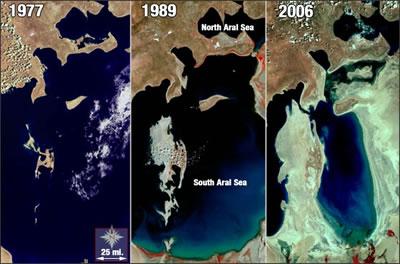The Aral Sea, whose disappearance counts as one of the world's worst environmental catastrophes, is making a modest recovery thanks to a series of water-management projects implemented by the World Bank and the government of Kazakhstan.
 Going, going, but not gone. The smaller northern portion, at least, is recovering.USGS / NASA
Going, going, but not gone. The smaller northern portion, at least, is recovering.USGS / NASAWhile the waters of the Aral Sea — now a chain of brackish lakes along the border of Kazakhstan and Uzbekistan — continue to shrink, one portion, the northern Aral in Kazakhstan, has been steadily rising thanks to improved flood levees and dam construction. Within the past year, the northern Aral has risen to the maximum holding capacity of its newly constructed dike — a process World Bank officials expected to take at least two or three years.
"The impact has been very swift and very important for the local people, both from a health point of view and from a livelihood point of view," says Joop Stoutjesdijk, team leader for the first phase of the World Bank's North Aral Sea project.
Building on this success, the Kazakh government is now conducting preliminary research for the next phase of their project.
Daene McKinney, an environmental engineer with the Center for Research in Water Resources at the University of Texas, Austin, and a former director of the United States Agency for International Development, says he is encouraged by the news. But he's not entirely optimistic. He points out that while the northern Aral is making a modest recovery, the southern Aral is still drying up.
"You have to be careful of being overly optimistic," he says. "If you ask: 'are they saving the Aral Sea?' the answer is clearly no."
High and dry
During the 1960s, the two rivers that fed the Aral — the Syr Darya, which empties into the northern Aral, and the Amu Darya, which empties into the southern Aral in Uzbekistan — were drastically diverted in order to increase agricultural efficiency under the Soviet regime.
The result is that the Aral, once the world's fourth largest inland body of water, has been steadily shrinking from the 67,000-square-kilometre sea that it was in the mid-1960s. At present it consists of a series of lakes, containing in total only about 10% of the sea's original volume1. Between 1987 and 1989 the water dropped severely, splitting the sea into two: the small northern Aral and the large southern Aral. Port towns were left stranded high and dry. "There were billions of cubic metres of water lost per year during the 1990s, says Stoutjesdijk.
Where there was once water and a thriving fishery, there is now desert wasteland, economic depression and disease; as the waters recede, they expose salt and sediment laced with agricultural residues — pesticides and chemical fertilizers — which have been linked to an increase in respiratory diseases and certain forms of cancer in the bordering communities.
Action plan
In 2001, the Kazakh government embarked on a US$85-million water-management project, securing $64.5 million in loans from the World Bank. The funds were used to improve the flow of the Syr Darya by constructing flood levees, improving hydraulic irrigation systems, and building dams to prevent over-spill from rivers and stop water draining from the northern Aral into the southern Aral.
Construction was completed in August 2005 and, by May 2006, the northern Aral had spread by nearly 900-3,300 square kilometres and risen by 3 metres — an impressive recovery. Previous attempts to contain the waters of the northern Aral with earthen dikes had failed and it wasn't clear whether or not the inflow originating from the Syd Darya river would be enough to significantly raise the water level.
With increased freshwater flow, the northern Aral's salinity is returning back to normal and, as a result, several species of freshwater fish have returned. And fishermen are once again casting their nets. "We're being told that for the first time since independence, they're exporting fish to the Ukraine again," says Stoutjesdijk.
North and south
McKinney says he is encouraged by the northern Aral's recovery. "It means that the water flow originating from the Syr Darya is enough to raise the northern Aral Sea up to levels that are adequate for the fish population and for the people who use them," he says.
ADVERTISEMENT
But to save the entire sea, he notes, all of the water that is currently diverted from the Syr Darya and Amu Darya rivers for agricultural use would have to be directed back into the Aral. This is entirely unrealistic because agriculture, particularly of cotton, is a pillar of the Kazakh, Uzbek and other central Asian economies.
Still, the Kazakh government is eager to enhance the recovery of the northern Aral, and has begun preparations for a second stage of the project. Stoutjesdijk says he will be meeting with the Kazakh government sometime in 2008 to discuss further funding.
Visit our aralsea_recovering.html">newsblog to read and post comments about this story.
